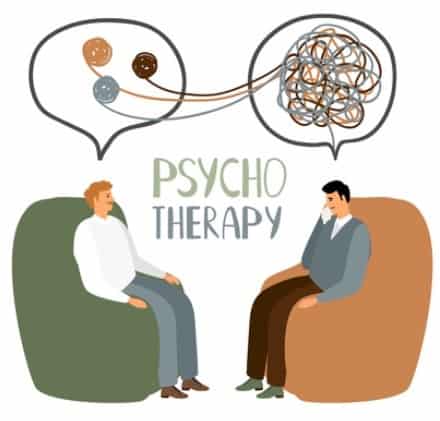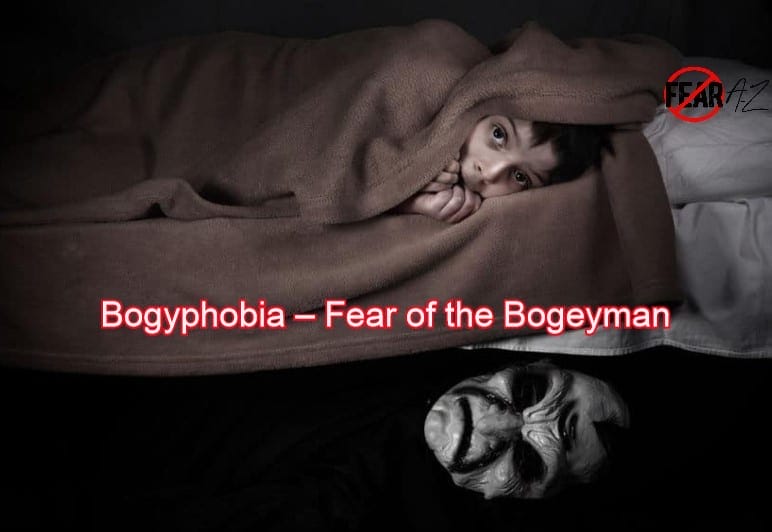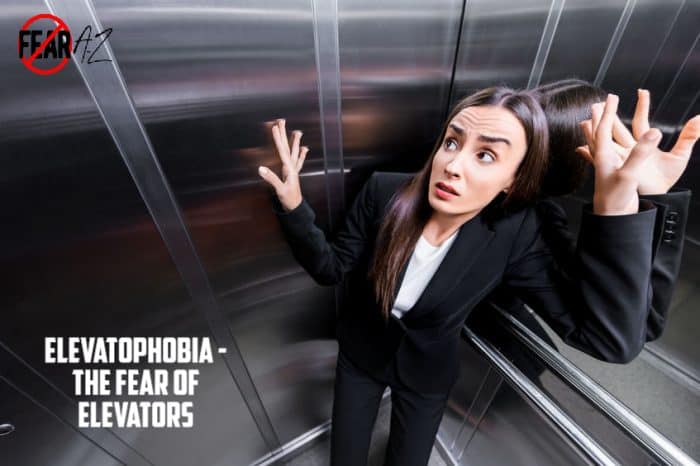Share This Article
Bogyphobia: Fear of the Bogeyman
The bogeyman may well be one of the most feared mythical creatures of all time. Often used in spooky childhood stories or to curb misbehaviors in children, we’re taught as kids that a bogeyman is hiding under the bed or in the closet lying in wait for us.
Though there isn’t a universal consensus on the bogeyman’s appearance, many describe him as having talons, claws, and sharp teeth. Based on different narratives, the bogeyman has been depicted as a witch, spirit, and demon. With such descriptions, is it any wonder some children excessively fear the bogeyman while some adults continue to experience an irrational fear of it?
For those of us who were never able to stop fearing the bogeyman, take heart. There are ways to get rid of or at lessen your fear and help you take back control over your life. Before we discuss bogyphobia treatment, however, let’s get a better understanding of what it is exactly.

Bogyphobia Definition
What is bogyphobia? According to the Diagnostic and Statistical Manual of Mental Disorders (DSM) V, the handbook used by healthcare professionals across the globe, bogyphobia is an anxiety disorder.
Bogyphobia Causes
Bogyphobia isn’t a hard phobia to understand. As its name implies, bogyphobia is an irrational and uncontrolled fear of the bogeyman. Since many of us have grown up hearing stories about the bogeyman and what it could do to us, people with bogyphobia experience great anxiety at the thought of coming face-to-face with the bogeyman even if it’s a mythical creature. Bogyphobia can also be the result of other people’s experiences (stories they might have shared with the sufferer) or genetics if you have family who had similar or related fears. It is a difficult way to live, but there are ways to manage it.
Symptoms
Like other phobias, anxiety is the main symptom of bogyphobia. Fearing the bogeyman, sufferers will exhibit extreme anxiety that could lead to panic attacks. Depending on the severity of the attack, hospitalization might be necessary in some cases. However, the triggers, intensity, duration, and specific symptoms will be different in each case and each individual.
People who have bogyphobia might suffer panic attacks and feel terrified at the irrational prospect of encountering the bogeyman. They will have little to no control over their negative responses and may engage in behavior they believe will save them from the bogeyman.
The Cycle of Avoidance Behavior
Sufferers may resort to activities that seem illogical to others just to keep the object of their fear away from them. They may refuse to go out at night, sleep with the lights on, refuse to sleep on a bed, or avoid staying in rooms with a closet. These behaviors can trap sufferers in a cycle because of the positive feelings they encounter whenever they feel like they’ve successfully evaded the bogeyman. They then try to recreate these feelings by repeating the behaviors.
If you think you may have bogyphobia, think of how you feel or react whenever the bogeyman is mentioned or comes to mind. Do you feel anxious, fearful, or upset? Have you been experiencing such anxiety for at least six months? If you’ve been haunted by the thought of the bogeyman for six months or more and have little control over your response, there’s a good chance you have bogyphobia.
Let’s take a look at the symptoms starting with the physical ones.
Physical Symptoms
- Trembling
- Cold/hot flashes
- Excessive sweating
- Dizziness
- Nausea
- Dry mouth
- Muscle tension
- Breathlessness
Mental/Emotional Symptoms
- Excess anxiety when thinking about the bogeyman
- Panic attacks
- Incapacity to manage anxiety
- Fear of imminent harm or danger
- Depression
- Rapid heartbeat
- Disorientation
- Avoiding situations where you think you might encounter the bogeyman
Bogyphobia Treatment
Regardless how long you’ve been suffering or how intense your phobia is, there are things you can do to regain control of the situation. Treatments generally fall under two categories: self-help and professional treatment. You may opt to try self-help tactics if your phobia isn’t too intense or you don’t have access to or resources for professional therapy. There’s no one right way to treat bogyphobia. The key is, however you decide to go about it, you need to stick to it. Persistent and consistent commitment are the keys to overcoming bogyphobia.
Self-Help Treatments
Exposure Therapy
Exposure therapy involves gradual exposure to the object of your fear over a given period. This is generally done with a therapist, however, if you feel you can handle it on your own, it can be a powerful tool for overcoming phobias.
To perform exposure therapy for bogyphobia, you can start by identifying an avoidance behavior that you would like to change and use that as a treatment milestone. This could be sleeping at night with the lights on if that is a struggle for you. You can start “exposing” yourself to the bogeyman by reading about it a little at a time until you become desensitized to it. Eventually, you can try sleeping with a night light on until the time comes when you’re ready to sleep in total darkness.
Decreased Caffeine Consumption
Caffeine is notorious for increasing anxiety. It can cause rapid heart rate and muscle tension. Consuming minimal or no caffeine might help decrease anxiety. By being more conscious of your caffeine consumption you can decrease some of bogyphobia’s associated symptoms.
Exercise
Cardiovascular exercise can alleviate one’s stress considerably. It’s been demonstrated to be an efficient means of releasing endorphins, those feel-good hormones. Exercise works by conditioning the mind to better cope with stressful situations. This makes sense when you consider the degree of stress the body undergoes during strenuous exercise. You might want to engage in some type of aerobic exercise to help better cope with bogyphobia symptoms. Various aerobic activities like biking, swimming, and jogging can help decrease phobia symptoms.
Yoga and Meditation
Yoga and meditation help because of their ability for redirection. By mindfully focusing on your breath or yoga pose, you are diverting your attention towards less stressful thoughts. Don’t expect instant results though. It will take some time before you start reaping the benefits. If your bogyphobia is severe, it may be better to have yoga and meditation as complementary therapies alongside other techniques like cognitive behavioral therapy and exposure therapy. You might also wish to enroll in a class, so they can guide you and help motivate you.
Professional Treatments
If you have access to professional treatment, consider this option because you’ll be under the guidance of someone who studied and prepared to treat those with phobias. Here are a few professional treatments available for phobias like bogyphobia.
Cognitive Behavioral Therapy
Cognitive behavioral therapy or CBT allows you to gain a better understanding of your behavior and thought patterns surrounding your fears. In many cases, a lack of insight is the reason for our fears. CBT can help you take a step back, understand your fears on a deeper level, and address them.
Exposure Therapy
Exposure therapy is best done under the supervision of a professional. It is one of the most effective ways of overcoming your fears. However, a therapist needs to be trained in exposure therapy so that he or she can administer the right level of exposure. Too little exposure and desensitization might not occur. Too much could be traumatic and lead the patient to abandon treatment.

Can I Avoid Bogyphobia?
Phobias, like most matters of the mind, are difficult to altogether avoid. Since they can be caused by genetics, personal experiences, or the way we were conditioned while growing up, there isn’t a way to consciously avoid them. Most fears creep up on us until our anxiety levels one day surprise us with their intensity. What we can control is what we do once we realize we’re in the grip of a phobia like bogyphobia. While it’s possible to do nothing about it, it’s better to confront the issue head-on and seek treatment.
Conclusion: Be Patient and Diligent During Treatment
Just as no one plans to have bogyphobia, no one can decide to just suddenly get rid of it either. You can, however, seek treatment for it. The best therapy is usually one that combines self-help and professional therapy so that your recovery is as holistic as possible. If you suffer from bogyphobia, be patient with yourself and be diligent with your treatment plan. Eventually, you’ll see results and reclaim your life.



